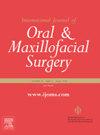Automatic segmentation of the midfacial bone surface from ultrasound images using deep learning methods
IF 2.2
3区 医学
Q2 DENTISTRY, ORAL SURGERY & MEDICINE
International journal of oral and maxillofacial surgery
Pub Date : 2025-01-28
DOI:10.1016/j.ijom.2025.01.012
引用次数: 0
Abstract
With developments in computer science and technology, great progress has been made in three-dimensional (3D) ultrasound. Recently, ultrasound-based 3D bone modelling has attracted much attention, and its accuracy has been studied for the femur, tibia, and spine. The use of ultrasound allows data for bone surface to be acquired non-invasively and without radiation. Freehand 3D ultrasound of the bone surface can be roughly divided into two steps: segmentation of the bone surface from two-dimensional (2D) ultrasound images and 3D reconstruction of the bone surface using the segmented images. The aim of this study was to develop an automatic algorithm to segment the midface bone surface from 2D ultrasound images based on deep learning methods. Six deep learning networks were trained (nnU-Net, U-Net, ConvNeXt, Mask2Former, SegFormer, and DDRNet). The performance of the algorithms was compared with that of the ground truth and evaluated by Dice coefficient (DC), intersection over union (IoU), 95th percentile Hausdorff distance (HD95), average symmetric surface distance (ASSD), precision, recall, and time. nnU-Net yielded the highest DC of 89.3% ± 13.6% and the lowest ASSD of 0.11 ± 0.40 mm. This study showed that nnU-Net can automatically and effectively segment the midfacial bone surface from 2D ultrasound images.
利用深度学习方法从超声图像中自动分割面中骨表面。
随着计算机科学技术的发展,三维超声技术取得了很大的进步。近年来,基于超声的三维骨建模备受关注,并对其在股骨、胫骨和脊柱中的准确性进行了研究。超声的使用使骨表面数据的获取无创和无辐射。骨表面徒手三维超声大致分为两个步骤:从二维(2D)超声图像中分割骨表面和利用分割后的图像对骨表面进行三维重建。本研究的目的是开发一种基于深度学习方法的二维超声图像中人脸中骨表面的自动分割算法。训练了6个深度学习网络(nnU-Net、U-Net、ConvNeXt、Mask2Former、SegFormer和DDRNet)。通过Dice系数(DC)、intersection over union (IoU)、第95百分位Hausdorff距离(HD95)、平均对称表面距离(ASSD)、精度、召回率和时间对算法的性能进行了比较。nnU-Net的DC最高为89.3%±13.6%,ASSD最低为0.11±0.40 mm。本研究表明,nnU-Net可以自动有效地从二维超声图像中分割面中骨表面。
本文章由计算机程序翻译,如有差异,请以英文原文为准。
求助全文
约1分钟内获得全文
求助全文
来源期刊
CiteScore
5.10
自引率
4.20%
发文量
318
审稿时长
78 days
期刊介绍:
The International Journal of Oral & Maxillofacial Surgery is one of the leading journals in oral and maxillofacial surgery in the world. The Journal publishes papers of the highest scientific merit and widest possible scope on work in oral and maxillofacial surgery and supporting specialties.
The Journal is divided into sections, ensuring every aspect of oral and maxillofacial surgery is covered fully through a range of invited review articles, leading clinical and research articles, technical notes, abstracts, case reports and others. The sections include:
• Congenital and craniofacial deformities
• Orthognathic Surgery/Aesthetic facial surgery
• Trauma
• TMJ disorders
• Head and neck oncology
• Reconstructive surgery
• Implantology/Dentoalveolar surgery
• Clinical Pathology
• Oral Medicine
• Research and emerging technologies.

 求助内容:
求助内容: 应助结果提醒方式:
应助结果提醒方式:


